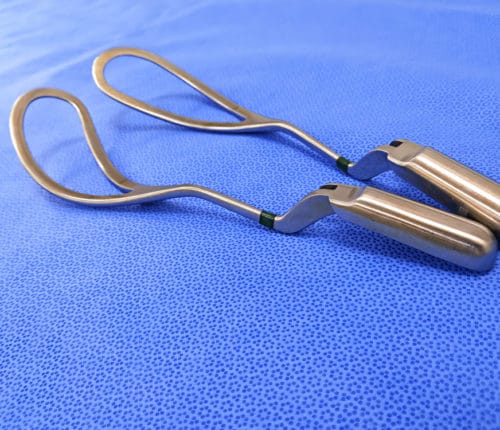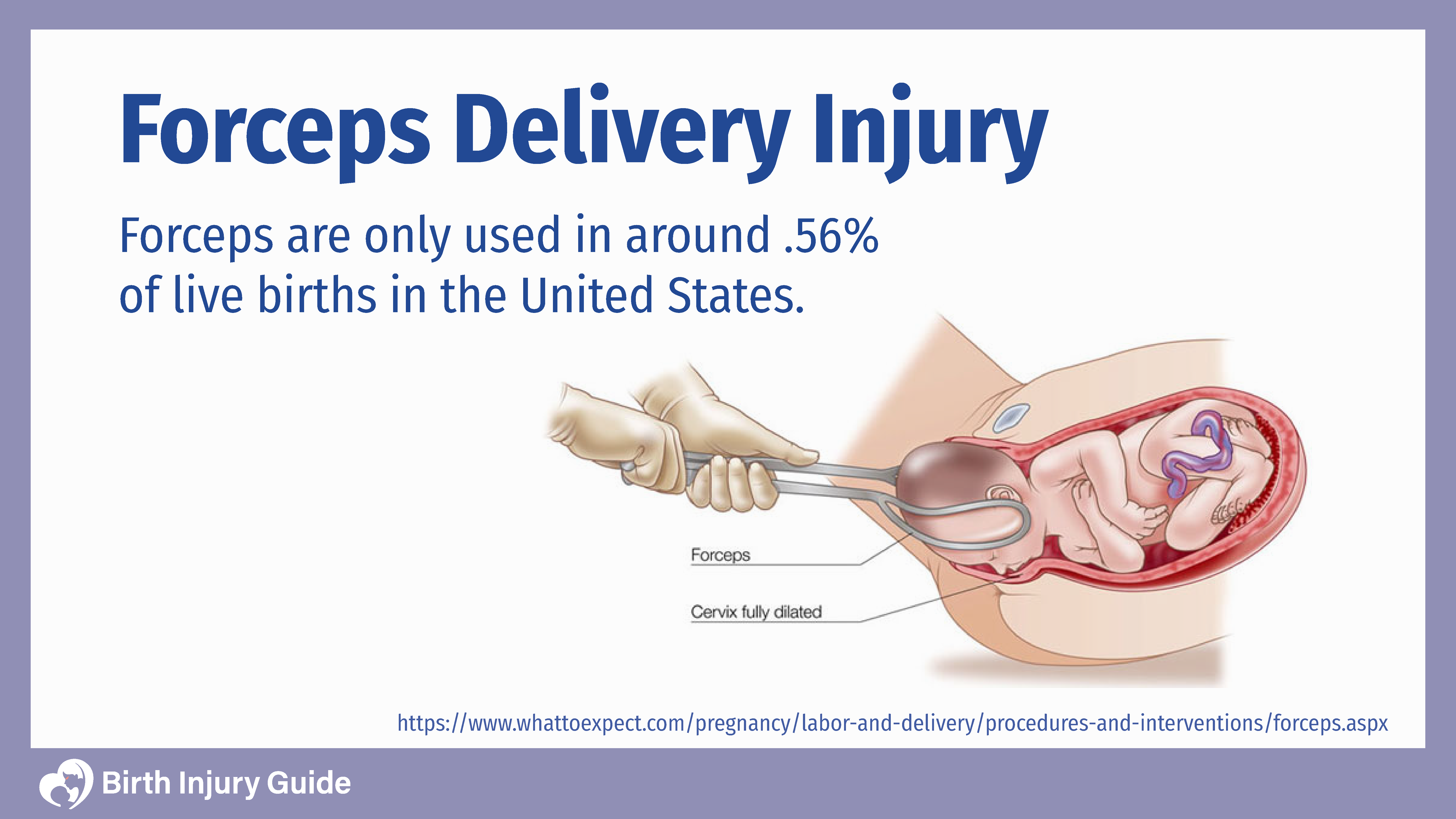
Forceps Delivery Injury
Birth-assisting tools have been commonplace during difficult deliveries for many decades. Forceps are designed to help deliver the baby if the mother becomes too tired to push, if the baby is in distress or if the baby is in a suboptimal position. Although they are certainly beneficial when used appropriately, the percentage of birth injuries associated with forceps, continues to be a cause for concern among experts and healthcare advocates.
Even though statistics show that a forceps delivery injury can be a very a real and serious problem, physicians continue to use them, despite the chances of inflicting trauma on infants. The use of forceps has declined in recent years, and doctors increasingly prefer vacuum extraction when an assistive tool is needed. Improper use of these tools can lead to serious birth injuries like nerve damage and brain injuries. A forceps injury can cause long-term medical conditions like brachial plexus injuries or cerebral palsy.

What are Forceps?
A pair of forceps is a birth-assisting tool that closely resembles large salad tongs. They have two curved cups that are open to the middle. The open end of forceps are placed around the infant’s head to help guide the baby out during the mother’s contractions. Forceps are made from sterile, surgical grade materials and are designed to cradle the baby’s head. There are different varieties of forceps that are used depending on the situation and the position of the baby.
- Elliot: Elliot models have a more rounded curve to them. They are used in cases where the baby’s head is very rounded.
- Kielland: Kielland models are the most common, and are mostly used to help rotate the baby in the birth canal. These have a shallow pelvic curve and a sliding lock.
- Piper: Piper’s forceps are designed for use in breech deliveries. They have a downward curve that fits around the baby’s body.
- Simpson: Simpson forceps are most often used when the baby’s head is being squeezed by the birth canal. The cephalic curve is elongated to help fit between the head and the birth canal.
- Wrigley: Wrigley’s forceps are mostly used when the baby is far down the birth canal. The short tong-like blades and stems help minimize uterine rupture and other injuries.
Forceps have been used in hospitals across the world for many years. While most women hope to deliver without assistance, sometimes complications lead to the mother needing a bit of help.
Why Doctors Use Forceps
The most common reason that doctors reach for the forceps is when the mother is unable to push the baby through the birth canal on her own during vaginal delivery. This can happen for a variety of reasons including maternal exhaustion, non-reassuring fetal well-being, a prolonged second stage of delivery, illness or infection, hemorrhage or when drugs keep the mother from being able to push the baby out successfully.
Doctors should always advise parents on what is happening and get their consent to use forceps during vaginal delivery. Most physicians acknowledge that sometimes there is a risk of injury, but if there are other problems, such as fetal distress during labor and delivery, they may turn to birth assisting tools for assistance. In almost all cases, forceps are not used unless there is a means to perform an emergency cesarean section surgery (C-section) within 30 minutes should the use of forceps prove unsuccessful, which is the standard at all hospitals and birthing centers.
During a delivery with forceps, it is important that healthcare providers closely monitor mother and baby. At any signs of maternal or fetal distress or other complications, the birthing plan should be quickly re-evaluated.
When Should Forceps Not be Used?
In most of the labor and delivery issues where a doctor would use forceps, a c-section would also be an option to help deliver the baby. While doctors often reserve c-sections as a “last resort”, there are some situations where forceps simply should not be used and the doctor should evaluate other possibilities. Some of those situations include:
- If the baby has a medical condition that affects how strong their bones are
- If complications arise when the baby is at the back of the birth canal
- When the baby’s position is awkward and forceps cannot be appropriately placed
- When the mother’s pelvis is too small to accommodate the baby safely
In these situations, using forceps could increase the risk of birth injuries, and could unnecessarily cause trauma for both the mother and baby.
What are the Risks of Using Forceps?
Complications during labor and delivery often happen in a flurry of decisions and movements. The decision to use forceps is one that the doctor will make after consulting the parents. Sometimes, there is time for the doctor to explain the risks to the mother before attempting vaginal delivery, in which case, she may have a choice between forceps or a cesarean delivery. However, there are also many times when complications arise quickly and doctors must make decisions quickly.
In either case, it is important that women and expectant parents understand the risks of forceps and possible delivery injuries.
Maternal risks include:
- Tears and lacerations in the lower genital tract area
- Fecal and/or urinary continence
- Perineum pain
- Anemia
- Bladder injuries
- Urethra injuries
Most of the possible injuries to the mother are minor and women generally recover with a favorable prognosis. The possible injuries to infants, however, are much more serious.
Infant risks include:
- Facial palsy (paralysis)
- Facial injuries
- Bruising and swelling on the baby’s head
- Shoulder dystocia
- Skull fractures
- Seizures
- Brain damage
Injuries like brain damage or skull fractures can have a tremendous impact on the baby and their future. These serious injuries are not common with forceps use, but they do happen. Expectant parents should be aware of any possible risks so they can make the best decisions possible.
How do I Know if My Baby Has Been Injured?
In most instances, the symptoms of a forceps injury are straightforward, such as lacerations or bruising. Other symptoms can include:
- A misshapen head (such as with a newborn hematoma, or cephalohematoma)
- Obvious nerve damage, such as facial paralysis
- Skull fractures
- Intracranial hemorrhage
- Seizures
Forceps deliveries rarely result in serious injury, but you should take a forceps delivery injury seriously. Be certain to have your doctor assess your baby’s head and brain for a number of birth injuries that may pose serious health issues, including:
- Seizure disorders
- Neonatal stroke
- Neonatal hypoxic ischemic encephalopathy (HIE)
- Cerebral palsy
Forceps and Permanent Disabilities
While serious or life-threatening birth injuries from birth-assisting tools is quite rare, they do happen. And the truth is that no one can predict when or where, or whom it may affect. All it takes is a little too much force or pressure on the baby’s head to cause extensive brain damage. Some of the long-term or permanent injuries that can occur during forceps deliveries include:
Cerebral Palsy
Cerebral palsy is a disorder caused by brain damage that causes motor deficiencies. Brain damage that causes cerebral palsy may occur any time around birth, including during delivery. There are many variations of cerebral palsy, so children with the disorder may experience a variety of different symptoms. People with cerebral palsy experience:
- Partial or complete paralysis in the arms and/or legs
- Lack of muscle control and coordination
- Shaky or spastic bodily movements
- Abnormal reflexes
- Difficulty walking
- Behavioral disabilities
- Developmental delays
- Pain
Cerebral palsy is a permanent birth injury. There is no cure for cerebral palsy, but there are treatment methods that can manage symptoms and help the child have the best quality of life possible.
Brachial Plexus Injury
A brachial plexus injury is an injury to the nerves that connect the spinal cord, neck, shoulder, and arm. The brachial plexus is a network of nerves that connect these areas and control sensation and movement. Any pulling or stretching of the baby’s shoulders during delivery can cause injuries to these nerves. As a result, the baby may experience:
- Weakness in the affected arm
- Weak grip
- Pain
- Lack of movement
- Loss of sensation
- Paralysis
Brain Damage
Brain damage is a serious birth injury. A difficult or prolonged delivery can cause brain damage in babies if the baby is not delivered quickly, or if there is physical trauma to the baby’s head. The longer a baby is in the birth canal, the greater the chances that they will suffer from oxygen deprivation. If doctors fail to perform an emergency cesarean delivery, there is a greater risk of serious birth injuries. Oxygen deprivation can cause severe brain damage that further leads to conditions like:
- Hypoxic ischemic encephalopathy (HIE)
- Seizures
- Cerebral palsy
- Cognitive disorders
- Developmental delays
In the most severe cases, infant brain damage can be fatal.
Do Parents Have a Choice?
Physicians not only have the responsibility to ensure that you and your infant are as safe as possible during a forceps procedure, but they are also obligated to inform you of the risks. Doctors must fully explain any procedures that they are doing, including using forceps, a vacuum extractor or ordering a c-section. The doctor must answer any questions that you have and address any concerns. If the situation is emergent or the mother is unable to participate in such discussions, her partner can ask questions on her behalf.
Women who are pregnant can also include certain wishes in a birth plan that they discuss with their doctor and/or midwife. If you do not want your doctor to use forceps, make sure that is part of your birth plan. Once labor begins, follow up on what’s happening and ask questions about the process.
It’s a common misconception that parents do not have a choice of the physicians using forceps or not. If you feel uncomfortable, you can always recommend to forgo it and undergo a cesarean delivery. Or, if the baby is stable, allow a longer second stage (pushing stage) of delivery. If the situation is emergent, verbal consent to using forceps is all that is necessary. However, if the doctor thinks an emergency c-section may be necessary, then signed consent should be obtained in advance.
Forceps and Medical Negligence
If you experience complications during labor and delivery, your healthcare team has a responsibility to make the best decisions possible for you and your baby. They must also adhere to medical standards when diagnosing or treating any type of disorder. If a doctor chooses to use forceps when a c-section would be safer or more appropriate for the baby’s health, then the baby suffers brain damage from the forceps, the doctor may be held liable for medical negligence. Similarly, if a doctor uses forceps improperly or with too much force or pressure and causes injuries to the baby, then the doctor can also be held liable for those injuries.
Being held liable means that the doctor is responsible for causing the baby’s injury and any related damages to the baby and family. That means the doctor could be sued via a birth injury claim for compensation for the family’s hardship. Compensation in a birth injury claim may include medical expenses, lost income of one or both parents, pain and suffering, and anticipated medical or care costs.
Start Your FREE Case Review Today
If you or your child is injured as a result of medical negligence, call us to learn more.



